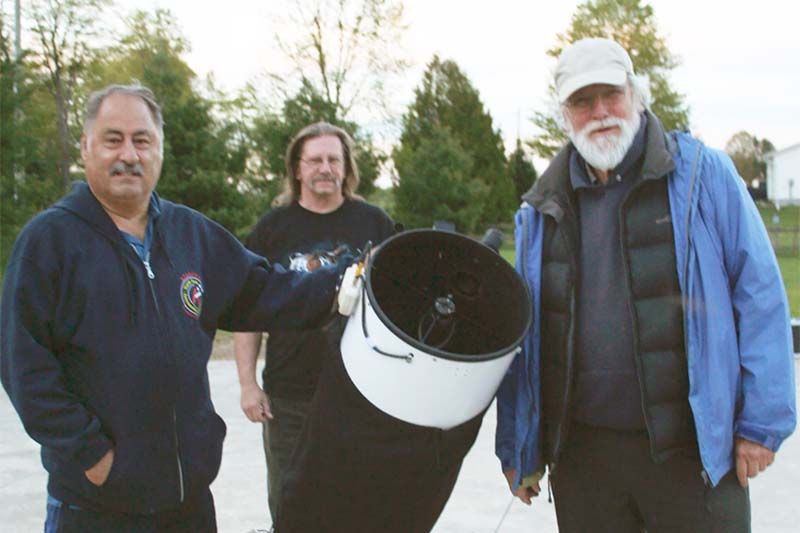Craig Bakay | May 24, 2017
It’s a quiet evening with a few clouds in the sky and annoying clouds of blackflies when the breeze fades every few moments or so.
And then . . .
“Jupiter!” shouts amateur astronomer Guy Nason, pointing to the southern sky.
As if by magic, the clouds part, the bugs are gone and four fancy telescopes start whirring into action.
Within minutes, there are images of our solar system’s largest planet, complete with all four Galilean moons available for all who want to see.
It’s relatively rare to catch Io, Europa, Ganymede and Callisto in the same frame as it’s seems there is always one or more behind the gas giant when you get a chance to look at it through a decent telescope. (By the way, Callisto was the one at the far edge of the frame by itself.) Although none of Jupiter’s other 63 moons were visible, two distinct cloud bands were and later on in the evening, the Great Red Spot put in an appearance traversing the disk.
“It’s (Jupiter) the jewel of the sky,” said Nason. “We’re so lucky is well-placed in the sky for the next few weeks.”
Stargazers also got a decent view of Messier-13, the globular star cluster in the constellation Hercules discovered in 1714 by Edmond Halley. Also visible were Messier-64, the Black Eye Galaxy and Messier-65, one of the Leo Triplet galaxies, in the same frame.
It’s difficult to say just how many observers visited this site over the course of the night but at its peak there were at least 20 people on the pad, including a couple of young families.
“I’m counting 30-40 in my report,” joked Coun. John Inglis, who was representing Council at the season opening. “I’m not particularly interested in astronomy but I am impressed by the equipment here.”
One of the great things about the star pad is the presence of volunteers like Nason, Verona’s Tim Trentadue and astronomer-in-residence Gary Coleman, all of whom bring good gear with them to let others experience the night sky.
“I enjoy sharing the night sky with people,” said Coleman.
“And remind (Mayor) Ron Higgins that he promised to paint north-south lines on the pad for us,” said Nason.
There are five more planned events at the pad this summer including:
• June 3: Gibbous moon near Jupiter. Moon shadows on Jupiter around 10:22 p.m. and lunar mountains and craters up close
• July 22: Summer constellations, Jupiter, Saturn and summer Milky Way
• August 12: Perseid meteor shower, despite the moonlight, a meteor per minute could be visible. Also the summer Milky Way
• September 10: Last chance to see Saturn, its rings and moons this year. Spotting Uranus with the naked eye a distinct possibility
• October 14: The autumn sky and a second chance to see Uranus unaided. Our nearest major galaxy, the Andromeda Galaxy, is well-placed.
Also a summer campout is potentially in the works.
More Stories
- September Closures for Northbrook And Sharbot Lake Beer Stores
- This "Doc Is Not In Anymore" After 54 Years
- Mazinaw Lake Swim Program Only Getting Stronger After 53 Years
- "Jack of Diamonds, Jack of Diamonds" but No Ace Of Spades Yet
- Sydenham Legion Presents ATV to Canada Day Raffle Winner
- Bathing in Blue Mindfulness: An Otter Lake Journey in Frontenac Park
- Central Frontenac Buys Used Pumper At Special Meeting
- 4th Annual Sharbot Lake Beach Bash
- Frontenac ATV Club Rallies For A Community Cause
- Harrowsmith Shadowdale Blooms: Kindness In Full Colour

